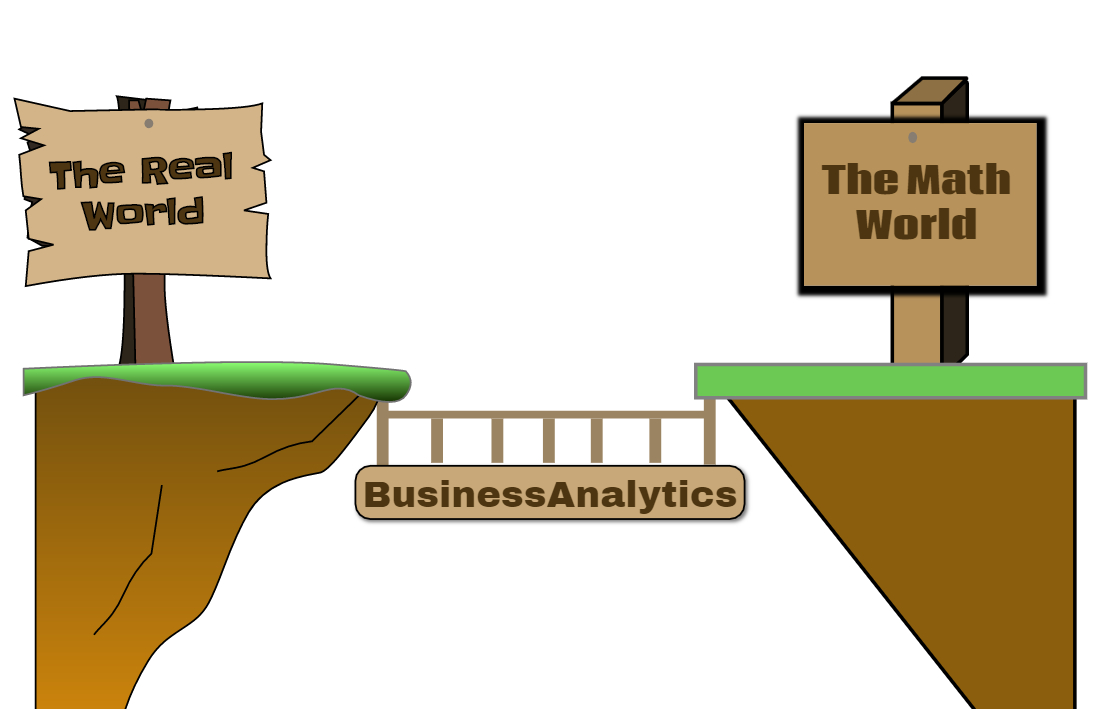Chapter 2 Becoming a Data-Driven Business Analyst
Figure 2.1: The acronym BAW refers to the business analyst workflow. We use the acronym as it is easier to write and inspires the saying “release the BAW”. While most people are more familiar with “release the kraken” (google it if not familiar), please note that the BAW has as big an impact on decision makers as the Kraken has on sailors.
2.1 The Business Analyst’s Perspective of Business Analytics
We, as business analysts, create value by compelling actions or change within our firm. Calls for action or change are most successful when aligned with strategy and informed with data. This is the job of the business analyst; to drive better outcomes by compelling actions that are aligned with strategy and informed by data. This value creation process is called the business analyst workflow (a.k.a, the BAW). The BAW is powerful - like a menacing and intelligent Kraken (Figure 2.1). At its heart, the BAW leverages analytics - a set of computationally-driven methodologies and tools which help convert raw data into valuable insights and/or more accurate predictions. A rich subset of these tools that:
Analytics refers to the collection of computationally-driven methodologies and tools used to convert raw data into valuable insights and/or more accurate predictions.
- work well together,
- add value to almost all potential data-driven use cases for business, and
- truly lead to world-class BAW
are all gently, yet rigorously, introduced in this book. These tools include names you may or may not know yet - R, Rstudio, the tidyverse (e.g. ggplot2, dplyr), graphical models, Bayesian inference, numpyro, and causact. Whether you know them all or know none of them - no worries - this book will show you how to make them all play together as you become a world-class BAW practitioner.
Embracing the business analyst workflow (BAW) depicted in Figure 2.2 will give you a much richer skillset than just learning business analytics tools by themselves. The combined BAW skillset is powerful - often intimidating - and sometimes challenging to harness properly. To that end, and to provide a metaphor that evokes the right feelings, I encourage you to use an imposing tone and command yourself to “release the BAW!” just like Zeus commands to “release the Kraken!” in the movie Clash of the Titans.
Figure 2.2: The business analyst transforms strategy and data into actionable insights that improve business outcomes.
The BAW, pictured in Figure 2.2, starts with strategy, expertise, and data as inputs and results in the business analyst leading their firms to act on value-adding insights. While many courses or books focus on aspects of the BAW or some specifics of analytics, they are at best a disconnected set of components that likely fall short of supporting a full value-creation workflow. Within this book, however, you will learn a connected set of components and integrated tools that support the complete BAW. Four benefits of learning business analytics within the context of the BAW are worth calling attention to:
Outcome-focused: A good business analyst achieves good outcomes; otherwise what is the purpose of fancy models, big data, and cool charts? The BAW is outcome-focused and encourages its purveyors to not focus exclusively on good reports, or good statistical results, or implementing fancy algorithms with intimidating names like random forests and neural networks. At the end of the day, we stay focused on achieving good outcomes.
Strategically-aligned: Not all outcomes are created equal. Companies seeking to capture market share might increase expenses to aid market capture. Companies seeking to be cost leaders might leave some customers unsatisifed to keep expenses low. So a one-size-fits-all approach to defining good outcomes is ill-advised. For this reason, the BAW outcomes on the right-side of Figure 2.2 are informed by a firm’s strategy shown on the left-side of Figure 2.2.
Action-oriented: A business analyst’s job is to inspire action, not just provide insight. So, delivering a good report is insufficient if the firm fails to act on the recommendation(s). Additionally, insight is worthless if it does not alter future behavior. In this book, we will learn to create compelling visuals of models and data that articulate the call to action being made, and additionally base our insights in stories, expertise, and models that all business stakeholders can relate to.
Computationally Rigorous: The core capability of the business analyst, modelling to generate insight, is where you will spend a majority of your effort while working through this book. This conversion of strategy, expertise, and data into insights relies heavily on working at the leading frontier of computational tools. At this frontier is the mathematical field of Bayesian inference and the computational tools like
numpyrothat support it. You will find this particular toolset to be flexible in modelling most business issues/processes, accommodating to beliefs and managerial opinions that are not captured within historical data, and enormously interpretable in terms of generating actionable insight.
The focus of this book is on business analytics in support of the BAW, but another related and valuable workflow is worth discussing for the contrast it provides. The machine learning analyst workflow (MLAW), pictured in Figure 2.3, shows models that focus on making prediction as opposed to generating insight. The models and accompanying business analytics tools most useful within this workflow are usually of a different form than those we will learn while mastering the BAW; they debatedly tend to yield better predictions, but often at the expense of insight, causal reasoning, interpretability, and ability to incorporate expertise into the model.
Figure 2.3: The machine learning analyst transforms historical data with known outcomes into future outcome predictions.
In this book, we will learn to make generative models of data; models, which as will be shown, provide interpretable reflections of how the data might be generated in the real world. Models used in the MLAW workflow tend to be discriminative models; these models excel at prediction, but typically do not yield insight into how the underlying data get generated or the real-world interpretability of how its predictions are made. These two types of models are complementary and context will dictate which is more appropriate to follow.
The MLAW is valuable in the sense that anytime a human or computer is making a prediction, there is probably a model or algorithm that can enable the prediction to be made faster, better, and/or cheaper. Managers, along with business analysts, would be negligent to ignore these powerful tools as they can enable new business processes (e.g. personalized song recommendations on Pandora or Spotify) or improve existing ones (e.g. credit card fraud detection or matching incoming call center requests to the most qualified call center agents). Despite the value that can be provided by this related workflow, the focus of this book is on modelling to drive insight which inspires action. Often times this insight includes prediction, but those predictions will always be accompanied by both an interpretation of how model inputs (i.e. data) affect predictions as well as some causal reasoning suggesting how inputs might be manipulated to yield better outcomes.
2.2 The Real World and the Math World
The business analyst workflow consists of transforming the real-world into a compact mathematical representation that we can use, along with data, to computationally search for insights. These computational insights must then be translated back into the real-world in such a way that they inspire action which leads to improved outcomes. This is your role: transform the real-world into the math/computer world, extract mathematical/statistical/computational insight, then transform that insight into a compelling real-world call for action. Figure 2.4 depicts business analytics as one of the bridges that connects the real-world and the math world. We will seek to be experts in traversing this bridge.
 Figure 2.4: The math world is a stylized reflection of the real world. You will learn to traverse the business analytics bridge to bring business problems from the real world to the math world and actionable insights from the math world back to the real world.
Figure 2.4: The math world is a stylized reflection of the real world. You will learn to traverse the business analytics bridge to bring business problems from the real world to the math world and actionable insights from the math world back to the real world.
2.3 This is Your Journey
You are about to embark on a path that is curvy, mostly uphill, and not paved (see Figure 2.5 for motivation). The skills needed to become a world-class data-driven business analyst draw from a variety of challenging disciplines: business, communications, computer science, data science, decision theory, mathematics, statistics, and visualization. The combination of these disciplines is tricky, but rewarding and ultimately intuitive after the initial brain shock you might feel. Stick with it, embrace the productive struggle, and I promise you will become a guru in creating data-driven business value.
 Figure 2.5: Like a crab that sheds its shell to grow, you too might feel vulnerable at times when you grow as you journey through this book. This is normal - learn to embrace the productive struggle.
Figure 2.5: Like a crab that sheds its shell to grow, you too might feel vulnerable at times when you grow as you journey through this book. This is normal - learn to embrace the productive struggle.
Productive struggle is a state of mind where obvious solutions and simple answers to a problem seem elusive, yet despite this, one maintains faith that flexible thinking, perseverance, and sleep will yield positive outcomes.
“What people don’t realize is that world-class performers have reoriented their relationship to suffering, to the point of resistance, they have learned to embrace it, they’ve learned to see the beauty in these moments where there’s pain because there’s incredible room for growth.” - Josh Waitzkin (Tim Ferris Show Ep.2)
Since this is your journey, you will need to practice what is shown to you in this book. As such, this book is written from the perspective of an experienced guide that is sharing your journey; pronouns such as you, we, and I will be used to convey a sense that we are in this together, but you need to do your own walking. The journey will transform you into a competent data-driven business analyst who can successfully communicate and collaborate with business managers, computer programmers, statisticians, and the greater analytics community.
2.4 Consume This Book in Front of a Computer.
The journey is yours. While you may feel hesitant about your computational and quantitative abilities, do not let that stop you. Grab your computer and work through the examples presented in the book. Figure 2.6 shows a preview of the computer screen you will get very familiar with on your journey.
Figure 2.6: Picture of the RStudio interface. Use this interace to work through the code in this book.
Simply reading this book is not engaging the material at a level needed for mastery. Bring your curiosity, optimism, and perseverance, and I promise you will learn to be an analytics powerhouse by the end of your efforts.
2.5 Exercises
Exercise 2.1 In deciding between using the business analyst workflow (BAW) or the machine learning analyst workflow (MLAW), list three clear advantages of BAW models over MLAW models and the one primary advantage of MLAW models over BAW models.
Exercise 2.2 Explain why “having the ability to hear a professor’s lecture and then, take a quiz where the answers all seem easy and you get a 100%” is not productive struggle. Give a better example of productive struggle.